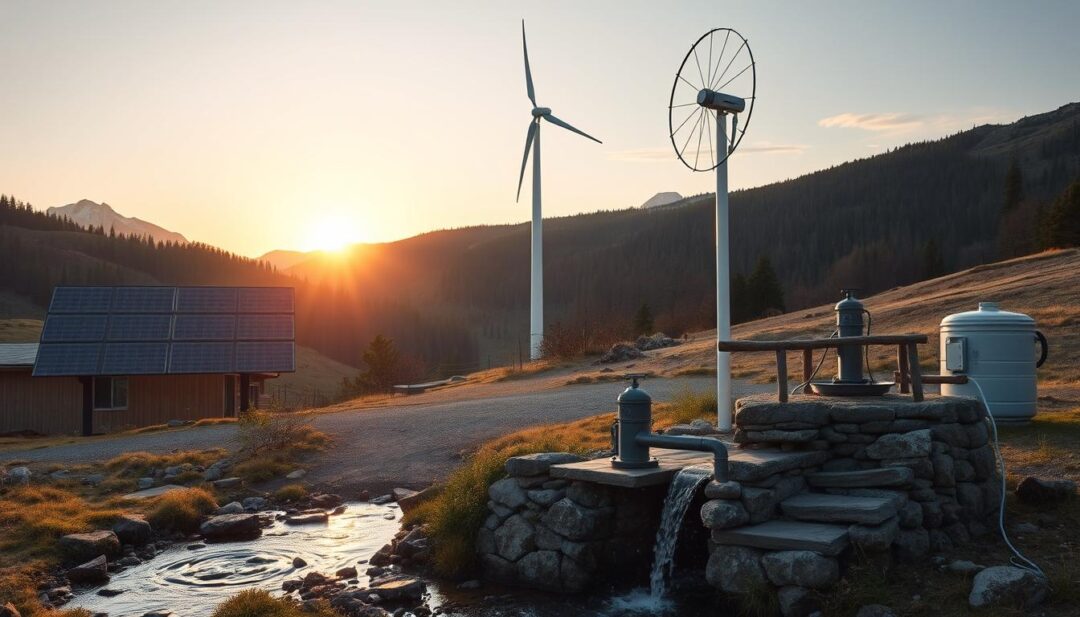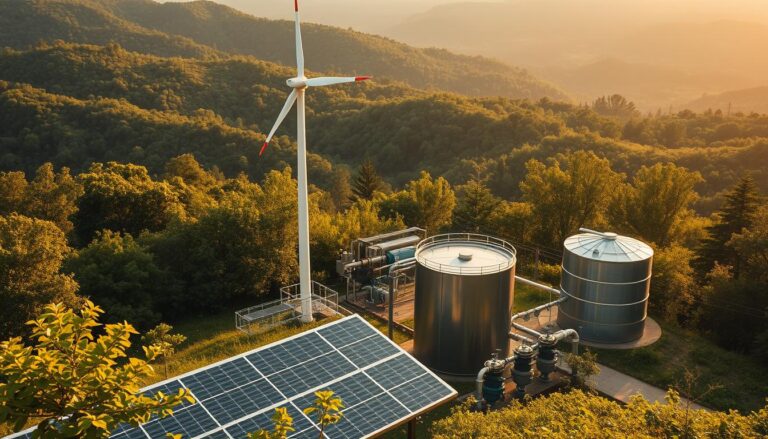Solar vs. Wind: What’s Best for Your Off-Grid Water Needs?
Did you know that millions of people worldwide lack access to reliable water sources, and the demand for off-grid water solutions is on the rise? As the world shifts towards renewable energy for water systems, the debate between solar and wind power has gained significant attention.
The choice between these two energy sources depends on several factors, including location and energy requirements. Understanding the advantages and limitations of each is crucial for determining the best solution for your off-grid water needs.
Key Takeaways
- Reliable access to water is a significant challenge globally.
- Renewable energy sources are becoming increasingly popular for off-grid water needs.
- The choice between solar and wind energy depends on location and energy requirements.
- Understanding the advantages and limitations of each energy source is crucial.
- Determining the best solution requires careful consideration of several factors.
Understanding Off-Grid Water Systems
Understanding the basics of off-grid water systems is essential for those looking to harness renewable energy for their water needs. These systems are designed to provide a reliable and sustainable way to access water in areas not connected to the municipal water supply.
Common Off-Grid Water Sources
Off-grid water systems typically draw from natural sources such as wells, springs, or surface water bodies like rivers and lakes. The choice of water source depends on geographical location, water availability, and quality.
Why Renewable Energy for Water Pumping?
Using renewable energy for water pumping is both environmentally friendly and cost-effective in the long run. Solar and wind power are the most common forms of renewable energy used for this purpose, reducing reliance on fossil fuels and lowering operational costs.
Basic Components of Off-Grid Water Systems
The basic components include the water source, a pump (either solar or wind-powered), a controller to regulate the pump’s operation, and sometimes a storage tank to hold water for later use. The efficiency of these components together determines the overall effectiveness of the off-grid water system.
By understanding these elements, individuals can better design and implement off-grid water systems that meet their specific needs, leveraging the benefits of renewable energy for water systems.
Assessing Your Water Requirements
To determine the best energy solution for your off-grid water needs, you first need to assess your water requirements. This involves understanding how much water you need daily, the capacity of your pumping system, and how your needs might vary across different seasons.
Calculating Daily Water Usage
The first step in assessing your water requirements is to calculate your daily water usage. This can vary significantly depending on whether you’re using water for drinking, irrigation, or livestock. For instance, a household might require between 200 to 400 liters per day for all needs, while irrigation demands can be much higher.
Determining Pumping Capacity Needs
Once you have an idea of your daily water needs, you need to determine the pumping capacity required to meet those needs. This involves considering the total dynamic head (the height water needs to be pumped from and to) and the volume of water needed. A table can help illustrate how different factors affect pumping capacity:
| Daily Water Need (Liters) | Total Dynamic Head (Meters) | Pumping Capacity Required (Liters/Minute) |
|---|---|---|
| 200 | 20 | 0.14 |
| 500 | 50 | 0.35 |
| 1000 | 100 | 0.69 |
Seasonal Variations in Water Demand
It’s also crucial to consider how your water needs change with the seasons. For agricultural purposes, water demand often peaks during dry summer months. Understanding these variations helps in designing a system that can meet your needs during the periods of highest demand.
Solar Power for Water Pumping: How It Works
The use of solar energy for water pumping systems is gaining popularity due to its efficiency and eco-friendliness. Solar power for water pumping offers a reliable and sustainable solution for off-grid water needs.
Solar Panel Basics for Water Systems
Solar panels convert sunlight into electrical energy, which is then used to power water pumps. The photovoltaic (PV) cells in solar panels are designed to capture the sun’s energy and convert it into DC power. This DC power is either used directly by the pump or stored in batteries for later use.
Types of Solar Water Pumps
There are several types of solar water pumps available, including submersible pumps, surface pumps, and floating pumps. Submersible pumps are ideal for deep wells, while surface pumps are better suited for shallow water sources. The choice of pump depends on the specific water needs and the site conditions.
Battery Storage Considerations
Battery storage is an essential component of a solar water pumping system, as it allows for water pumping even when the sun is not shining. The size and type of battery storage needed depend on the pumping capacity, water demand, and the amount of sunlight available.
System Sizing Guidelines
Proper sizing of a solar water pumping system is crucial to ensure it meets the water needs efficiently. The system size depends on factors such as the daily water requirement, the depth of the water source, and the available solar radiation. A well-sized system ensures optimal performance and minimizes energy waste.
| System Component | Factors to Consider | Importance |
|---|---|---|
| Solar Panels | Size, Efficiency, Cost | High |
| Pump Type | Depth, Flow Rate, Pressure | High |
| Battery Storage | Capacity, Type, Maintenance | Medium |
| System Sizing | Water Demand, Solar Radiation, Depth | High |
Wind Power for Water Pumping: How It Works
Wind power has emerged as a viable alternative for water pumping needs, especially in off-grid locations. This renewable energy source can significantly reduce reliance on fossil fuels and lower operational costs over time.
Wind Turbine Fundamentals
Wind turbines convert the kinetic energy from wind into mechanical energy, which can then be used to power water pumps. The turbines are equipped with blades that rotate as wind passes over them, driving a rotor connected to a generator or a mechanical pump.

Types of Wind-Powered Water Pumps
There are primarily two types of wind-powered water pumps: mechanical and electrical. Mechanical pumps use the rotational energy directly from the wind turbine to drive a pump, while electrical pumps use the wind turbine to generate electricity, which then powers an electric pump. The choice between these types depends on the specific water pumping needs and the local wind conditions.
Energy Storage Options
For wind-powered water pumping systems, energy storage is crucial for ensuring a steady water supply during periods of low wind. Batteries are commonly used to store excess energy generated by the wind turbine, which can then be used to power the pump when needed. For more information on using windmills for water delivery, visit this article.
Determining Appropriate Turbine Size
The size of the wind turbine required depends on several factors, including the water demand, the depth of the water source, and the local wind speeds. A larger turbine may be needed for higher water demands or deeper wells, while smaller turbines can suffice for lower demands or shallower sources.
| Wind Speed (mph) | Turbine Size (kW) | Water Pumping Capacity (gallons/day) |
|---|---|---|
| 5-10 | 1-2 | 1,000-2,000 |
| 10-15 | 2-5 | 2,000-5,000 |
| 15-20 | 5-10 | 5,000-10,000 |
Solar vs. Wind: What’s Best for Off-Grid Water Needs?
The decision to use solar or wind energy for off-grid water pumping depends on several critical factors. Both energy sources have their advantages and disadvantages, making the choice highly dependent on specific needs and circumstances.
Direct Comparison of Key Factors
When comparing solar and wind energy for off-grid water needs, several key factors come into play. These include the initial investment, operational costs, energy storage requirements, and the reliability of the energy source. Solar energy is abundant and can be harnessed using photovoltaic panels, which are relatively easy to install and maintain. On the other hand, wind energy requires a consistent wind speed to generate power efficiently, and the turbines can be more complex to install and maintain.
A direct comparison of these factors is essential to determine which energy source is more suitable for your off-grid water needs. For instance, if you live in an area with abundant sunlight but inconsistent wind patterns, solar energy might be the better choice. Conversely, if your location has consistent wind speeds, wind energy could be more reliable.
When Solar Makes More Sense
Solar energy is particularly suitable for locations with high solar irradiance. It’s also a good choice for smaller water pumping needs or when the initial investment needs to be minimized. Solar water pumps can be designed to operate during the day, storing water in tanks for use as needed, which can be a cost-effective solution.
When Wind is the Better Option
Wind energy is advantageous in areas with consistent wind speeds. It’s particularly beneficial for larger water pumping needs or when the energy demand is consistent throughout the day. Wind-powered water pumps can operate continuously, providing a reliable source of water.
Reliability and Consistency Factors
Reliability and consistency are crucial for off-grid water systems. Both solar and wind energy have their reliability factors; solar energy is generally consistent in sunny areas, while wind energy is reliable in windy locations. Understanding the local climate and energy needs is key to selecting the most reliable energy source.
In conclusion, the choice between solar and wind energy for off-grid water needs depends on a thorough analysis of your specific requirements, including the local climate, energy needs, and the initial investment you’re willing to make. By comparing these factors directly, you can make an informed decision that ensures a reliable and consistent water supply.
Climate and Geographic Considerations
The effectiveness of solar and wind energy systems for off-grid water pumping is heavily influenced by local climate and geographic conditions. Understanding these factors is crucial for making an informed decision about which energy source is best suited for your needs.
Solar Potential Across Different US Regions
The United States experiences a wide range of solar irradiance levels across different regions. Areas like the Southwest receive high levels of solar radiation, making solar power a highly effective choice. In contrast, regions with frequent cloud cover or shorter daylight hours during certain parts of the year may require larger solar arrays to meet energy demands.
Wind Resource Assessment
Wind resource assessment is critical for determining the viability of wind energy for water pumping. Factors such as average wind speed, turbulence, and wind direction play significant roles. Regions with consistent and moderate to high wind speeds are ideal for wind-powered systems.
Seasonal Variations and Their Impact
Both solar and wind energy are subject to seasonal variations. Solar energy production may decrease during winter months due to shorter days and potential snow cover, while wind patterns can change seasonally, affecting energy production. Understanding these variations is key to designing a reliable off-grid water system.
Terrain and Installation Challenges
The terrain of your location can significantly impact the installation and efficiency of both solar and wind energy systems. For instance, installing solar panels on uneven or shaded terrain can be challenging and may require additional equipment or adjustments. Similarly, wind turbines require sufficient space and may be affected by local topography.
| Factor | Solar Energy | Wind Energy |
|---|---|---|
| Regional Suitability | High irradiance regions like Southwest US | Regions with consistent moderate to high wind speeds |
| Seasonal Variations | Reduced energy production in winter | Variable energy production based on wind patterns |
| Terrain Impact | Shading and uneven terrain can reduce efficiency | Topography can affect wind flow and turbine placement |
By carefully considering these climate and geographic factors, you can make a more informed decision about whether solar or wind energy is best for your off-grid water needs.
Cost Analysis: Initial Investment vs. Long-Term Value
Evaluating the cost of solar versus wind energy for off-grid water needs involves several key factors. A comprehensive cost analysis is essential to determine the most economically viable option for your specific requirements.
Upfront Costs Breakdown
The initial investment for both solar and wind-powered water pumping systems includes the cost of equipment, installation, and any necessary infrastructure. For solar systems, this typically involves the cost of solar panels, a pump, and a controller. Wind-powered systems require a wind turbine, a pump, and often a tower for the turbine.
Key components to consider in upfront costs:
- Equipment costs
- Installation fees
- Infrastructure expenses
Operational Expenses Over Time
Operational expenses for renewable energy systems are generally lower than traditional fuel-based systems. However, maintenance costs can vary. Solar systems may require occasional cleaning of panels and checking of electrical connections. Wind turbines need periodic inspection of blades and bearings.
Return on Investment Calculations
Calculating the return on investment (ROI) for solar or wind-powered water pumping systems involves comparing the initial costs with the long-term savings. Factors to consider include the cost of fuel or electricity saved, maintenance costs, and any potential increase in property value.
Available Tax Incentives and Rebates
Both federal and state governments offer tax incentives and rebates for renewable energy installations. These can significantly reduce the upfront costs. For instance, the federal solar investment tax credit (ITC) allows homeowners and businesses to deduct a percentage of the solar system’s cost from their federal taxes.
It’s crucial to research and explore available incentives to maximize your ROI.
Real-World Applications and Case Studies
Numerous case studies highlight the success of solar and wind-powered water systems across various climates and applications. These real-world examples provide valuable insights into the effectiveness and potential of renewable energy sources for meeting different water needs.
Residential Water Supply Systems
In residential areas, solar-powered water systems have become increasingly popular due to their reliability and cost-effectiveness. For instance, a case study from a rural community in California showed that a solar-powered water supply system met the daily water needs of over 50 households, reducing their reliance on diesel generators and lowering operational costs.
Agricultural Irrigation Solutions
Agricultural irrigation is another area where solar and wind energy have made a significant impact. A farm in Nebraska implemented a wind-powered irrigation system, which not only reduced their energy costs but also increased crop yields due to the reliable water supply. This example demonstrates the potential of wind energy in supporting agricultural productivity.
Livestock Watering Systems
Livestock watering is a critical application of solar and wind-powered water systems. A ranch in Texas successfully installed a solar-powered watering system, ensuring a consistent water supply for their cattle throughout the year, even during periods of drought. This system improved the health and productivity of their livestock.
Success Stories from Different Climates
Success stories from various climates further illustrate the versatility of solar and wind energy for water needs. For example, a solar-powered water system in a desert region of Arizona provided a reliable water supply for both residential and agricultural use, despite the harsh climate conditions.

| Application | Energy Source | Benefits |
|---|---|---|
| Residential Water Supply | Solar | Reliable, Cost-Effective |
| Agricultural Irrigation | Wind | Increased Crop Yields, Lower Energy Costs |
| Livestock Watering | Solar | Consistent Water Supply, Improved Livestock Health |
Conclusion
As we’ve explored throughout this article, renewable energy is crucial for off-grid water needs, offering eco-friendly water solutions that are both sustainable and reliable. When deciding between solar and wind power for your off-grid water solutions, it’s essential to consider your specific circumstances, including climate, water requirements, and geographic location.
Both solar and wind energy have their advantages, and the best choice depends on your particular situation. By assessing your daily water usage, determining your pumping capacity needs, and evaluating the solar and wind resources available to you, you can make an informed decision that meets your needs for renewable energy for water systems.
Implementing the right renewable energy solution not only reduces your reliance on fossil fuels but also provides a long-term, cost-effective approach to managing your off-grid water needs. As the demand for eco-friendly water solutions continues to grow, choosing the appropriate renewable energy source is a critical step towards a more sustainable future.







